Masala dosa is a beloved South Indian delicacy, often enjoyed as a comforting breakfast or light meal. It features thin, golden-brown crepes made from a naturally fermented batter of rice and lentils, filled with a mildly spiced, aromatic potato stuffing.
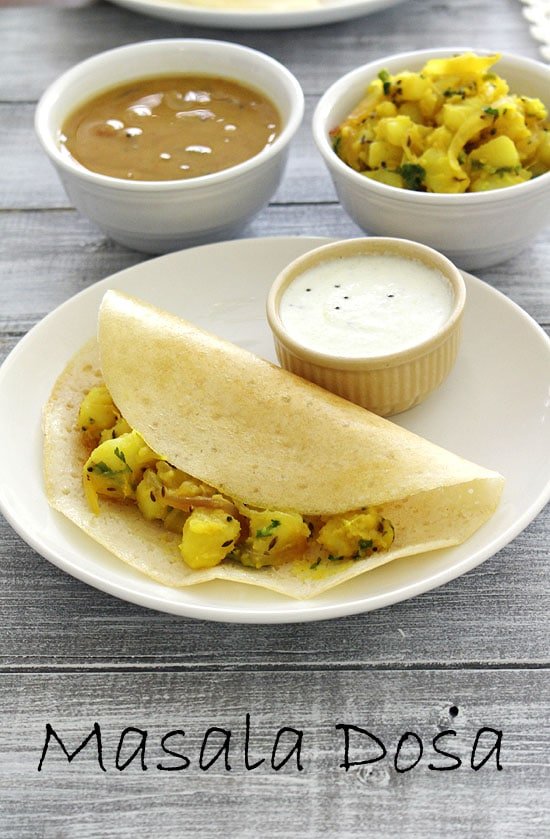
This dish holds a special place in my heart—every time I visit a South Indian eatery, I find myself drawn to either the classic masala dosa or the fiery Mysore masala dosa. There’s something about the crispy texture paired with that flavorful potato filling that’s simply irresistible.
When I prepare masala dosa at home, I prefer a version that’s medium in thickness but still crisp, especially around the edges. This recipe delivers exactly that. However, if you enjoy ultra-thin dosas with a papery texture, just spread the batter thinner on the hot tawa.
One common issue many beginners face is the dosa sticking to the pan. Don’t worry—it’s a common hurdle and completely fixable. I’ve included tried-and-tested tips in the step-by-step instructions to help you overcome this and get perfect results every time. The right pan, proper heat, and a bit of technique can make all the difference.
With just a bit of planning, you can enjoy restaurant-style masala dosas right in your kitchen—crispy on the outside, soft and savory on the inside, and full of authentic flavor.
Making everything from scratch requires some pre-planning, and it is a long process. So this is how I divide the tasks.
Day 1: Batter & Idlis Dinner
– I begin by soaking rice and urad dal two days ahead of when I plan to make dosa. I usually soak them in the morning so they’re ready to grind by evening.
– Once soaked, I grind them to a smooth batter and let it ferment overnight. Depending on the weather, fermentation takes around 12–18 hours.
– By the time dinner rolls around that day, the batter has fermented well and is ready for use. I prepare soft, fluffy idlis for dinner—fresh and light.
– After using some batter for idlis, I store the remaining batter in the refrigerator for the next day.
– To save time later, I also prepare a double batch of sambar and coconut chutney in the evening. Once cooled, I store them in airtight containers in the fridge.
Day 2: Masala Dosa in Under an Hour
– With the dosa batter, sambar, and chutney already ready, the next day’s work becomes minimal.
– I only need to make the potato masala in the morning. It’s a simple and quick preparation made with boiled potatoes, mustard seeds, onions, green chilies, curry leaves, and turmeric.
– With everything else already prepped, assembling and serving masala dosa becomes a breeze. The entire meal comes together in less than an hour.
This two-day approach helps me enjoy a homemade masala dosa feast without the stress. It also ensures that nothing goes to waste—batter and accompaniments are used efficiently.
Ingredients For Masala dosa:
For the Dosa:
- 4 cups of fermented Idli/Dosa batter – Use homemade or store-bought batter that’s well-fermented and slightly tangy.
- Oil or ghee, as needed – Use for greasing the pan and cooking the dosa. Ghee adds a richer flavor, while oil keeps it light and crisp.
For the Potato Masala Filling:
- 2 medium potatoes (or around 2 cups) – Boil until soft, then peel and chop into small pieces.
- 2 tablespoons oil – Any neutral oil like sunflower or groundnut works well for tempering.
- ½ teaspoon mustard seeds – Adds a classic South Indian aroma and crunch when tempered.
- ½ teaspoon cumin seeds – Adds warmth and an earthy note to the masala.
- 7–8 fresh curry leaves – Gives the filling its authentic southern touch.
- A small pinch (about ⅛ teaspoon) of asafoetida (hing) – Enhances the overall flavor and supports digestion.
- 1 medium red onion (about ¾ cup), thinly sliced – Adds sweetness and texture to the filling.
- 2–3 green chilies, finely chopped – Adjust according to your spice preference.
- 1 teaspoon ginger paste – You can use freshly grated or crushed ginger for a stronger flavor.
- ½ teaspoon turmeric powder – Adds color and a warm, earthy aroma to the dish.
- Salt to taste – Season the masala according to preference.
- ¼ cup water – Moistens the mixture and helps blend all the ingredients evenly.
To Finish the Masala:
- 2 tablespoons fresh coriander leaves, finely chopped – Sprinkle for a fresh, herbal touch.
- 2 teaspoons lemon juice – Adds a tangy touch and cuts through the heaviness of the potato masala.
How to make masala dosa Step by Step:
1) Begin preparing the dosa batter a day in advance. Soaking the rice and dal takes time, and the batter also needs several hours to ferment properly. For convenience, you can also use ready-made dosa batter available in stores.
2) For the potato masala: Pressure cook the potatoes for 2–3 whistles until soft. Once cooled, peel and chop them into small cubes.
3) Warm oil in a pan on medium flame. Once it’s hot, add mustard seeds and allow them to splutter.
4) Next, toss in the cumin seeds and let them crackle for a few seconds.
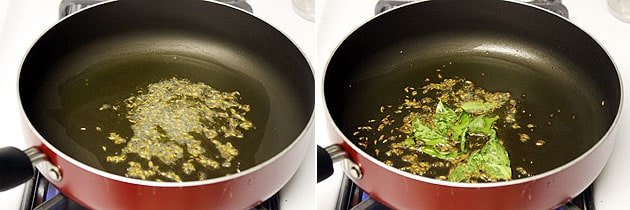
5) Stir in the curry leaves and let them release their aroma.
6) Add thinly sliced onions and sauté until they soften and become translucent.
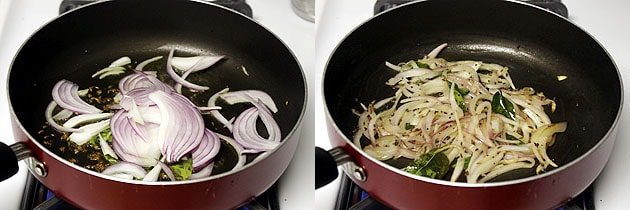
7) Now add chopped green chilies and ginger paste.
8) Cook for a minute until the pungent aroma of raw ginger disappears.

9) Sprinkle turmeric powder into the pan.
10) Mix well and cook for about 30–40 seconds to allow the turmeric to blend.
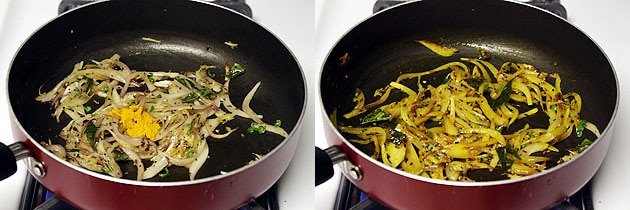
11) Pour in ¼ cup of water and bring it to a boil.
12) Stir in the diced potatoes along with salt as per your preference.
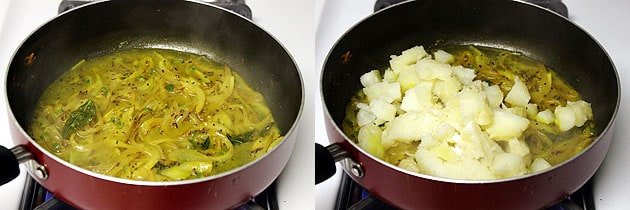
13) Stir everything together and cook for 3–4 minutes until the mixture is dry and well combined. Turn off the heat.
14) Top with chopped coriander leaves.

15) Add lemon juice for a fresh, tangy finish.
16) Mix well and cover the masala until you’re ready to use it.

17) Check the dosa batter. It should be of a thick yet pourable consistency. Add a little water to adjust, if needed. If using cold batter from the fridge, let it come to room temperature first.
18) Heat a cast-iron tawa or non-stick pan. It should be well-seasoned. Medium heat works best. If the tawa overheats, sprinkle some water to cool it down. Wipe off excess with a paper towel—this helps prevent sticking.

19) Pour a ladleful of batter in the center of the pan.
20) Gently use the back of the ladle to swirl the batter outward in a circular pattern.

21) Adjust the thickness as per your preference. Keep it thin for crisp dosas or a bit thicker for a softer texture. Avoid spreading it too thin, or it may tear while folding.
22) Lightly pour ghee or oil along the edges and across the top of the dosa.
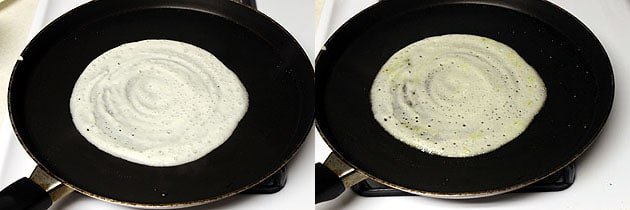
23) Cook for 1–2 minutes on medium-low heat, until the underside is golden and crisp. Don’t flip. Spoon 3–4 tablespoons of the prepared potato filling in the center.
24) Fold the dosa in half, carefully using a spatula.
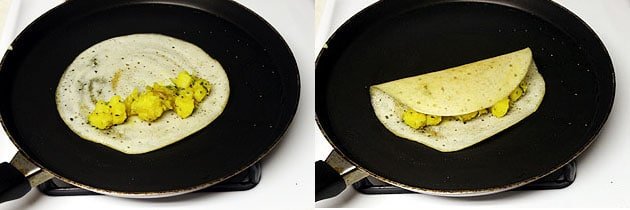
25) Transfer to a plate and serve hot with coconut chutney, sambar, or tomato chutney.
Serving suggestion For Masala dosa:
Enjoy the flavorful masala dosa served hot with a generous side of sambar and fresh coconut chutney. Whether you’re having it for breakfast, brunch, or a light meal, this South Indian classic is both satisfying and comforting.
Expert Tips for Perfect Masala Dosa:
1. Use the Right Proportion for Batter
A good dosa batter typically follows a 3:1 or 4:1 ratio, meaning three to four portions of rice for every one portion of urad dal. Including a tablespoon of fenugreek seeds (methi dana) while soaking helps improve fermentation and gives the dosa a beautiful golden hue and crisp texture.
2. Proper Fermentation is Key
Fermentation is the heart of a good dosa. Ensure you store the batter in a warm spot. In colder regions, place it inside an oven with the light on or near the stove. The batter should double in volume and have a mild, sour aroma when fully fermented.
3. Use a Well-Seasoned Tawa
When cooking on a cast-iron tawa, ensure it’s properly seasoned to prevent the dosa from sticking. If the pan isn’t seasoned well, the dosa may cling to the surface and tear. You can rub the tawa with a slice of onion dipped in oil between each dosa to prevent sticking and enhance flavor.
4. Don’t Pour Batter on an Overheated Pan
Make sure the pan is adequately heated but not overheated to the point of smoking. If it’s too hot, the batter will not spread properly. To bring down the temperature, sprinkle some water and wipe it off with a cloth before pouring the batter.
5. Serve Immediately for Best Taste
Masala dosas taste best when served hot and crisp. If left to sit too long, they lose their crunch. Serve them right off the pan with steaming hot sambar and freshly made coconut or tomato chutney.
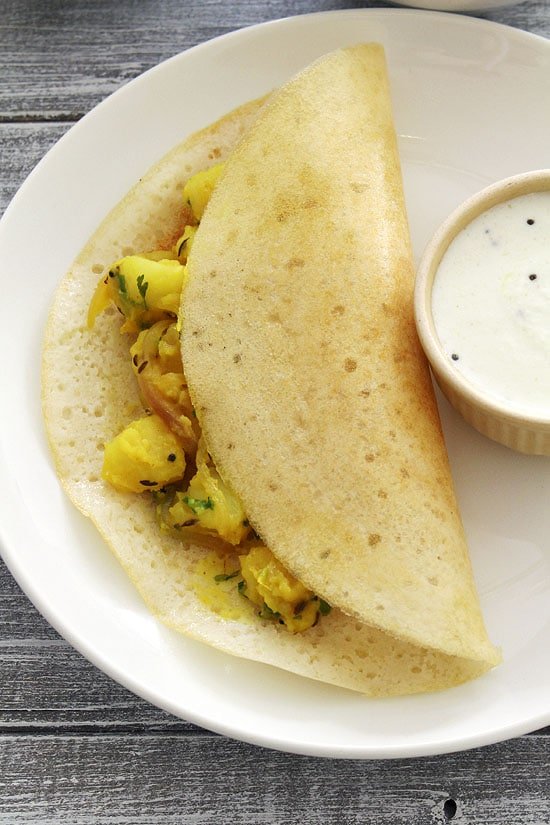
Variations You Can Try
– Mysore Masala Dosa:
Add a spicy red chutney (made from garlic, red chilies, and spices) before placing the potato masala. This version is bold, flavorful, and a favorite in Karnataka.
– Cheese Masala Dosa:
Kids love this twist. Sprinkle grated cheese over the potato filling before folding. Let it melt slightly—it’s delicious!
– Paneer Masala Dosa:
Mix some crumbled paneer into the potato mixture for a filling that’s rich in protein and extra satisfying. You can even replace potatoes entirely with a spiced paneer mixture.
– Mini Dosas for Snacks:
Make smaller dosas and serve them as appetizers or kid-friendly snacks with dips and mini chutneys.
